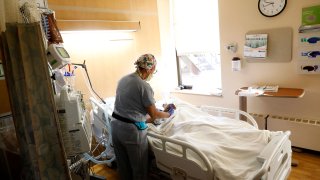
Coronavirus deaths in California have topped 80,000 and another 3,000 people are projected to die by month’s end even as infections, hospitalizations and intensive care cases are falling almost as fast as they climbed during the rapid-fire omicron wave of the pandemic.
The toll reached 80,688 on Friday, according to data collected by Johns Hopkins University.
That is the highest in the U.S., but the nation’s most populous state has a per capita death rate that is among the lowest at 38th. Texas has only a few hundred fewer deaths than California but has 10 million fewer residents and therefore a higher per capita rate.
“This milestone is a grim reminder of the real human toll of this pandemic,” said State Epidemiologist Dr. Erica Pan, who urged Californians to get vaccinated and boosted.
Get a weekly recap of the latest San Francisco Bay Area housing news. Sign up for NBC Bay Area’s Housing Deconstructed newsletter.
Another 220 deaths in California were reported Thursday and the state’s forecasting models show the death toll topping 83,600 by the end of February. Despite the grim tally, other indicators showed California is clearly past the peak of the latest and most infectious wave.
The state’s hospitalizations have fallen by more than 3,300 from their peak of 15,435 two weeks ago, which was well below the all-time high of nearly 22,000 in January 2021.
There were fewer than 2,300 intensive care patients, down 300 cases from 10 days ago and less than half the January 2021 number.
California
“We’ve definitely passed the peak and we are seeing a downward trend in the numbers, but we are not out of the woods yet,” Sacramento County health officer Dr. Olivia Kasirye said.
Hospitalization remain high in the state’s capital region and in many other regions and infection surges continue in places, including Sacramento County’s two jails. Nearly 5,000 of the California’s 97,000 state prison inmates are infected, along with 2,900 correctional employees.
But the state’s case rate and positivity rates have fallen from their highs in early January, and models predict the number of infected people will continue to decrease in all geographic regions.
The hopeful trends mean Los Angeles is among counties moving toward relaxing mask mandates. New cases in the nation’s most populous county Thursday were about a quarter of the record daily caseload of several weeks ago.
About 3,200 infected people remained hospitalized in Los Angeles County on Thursday, but the number has been falling and public health director Dr. Barbara Ferrer said the winter surge will be considered over when its falls below 2,500 for seven days in a row.
Once that threshold is met, Los Angeles County will end a mask requirement for large outdoor events such as concerts and sporting events and for outdoor spaces at schools and child-care facilities.
Indoor mask requirements will remain in force until the county has two straight weeks at or below a “moderate” rate of 50 new cases per 100,000 people and there aren’t any reports of a new, troubling variant circulating, Ferrer said. The case rate now is nearly three times higher than the threshold.
“Post-surge does not imply that the pandemic is over or that transmission is low, or that there will not be unpredictable waves of surges in the future.” Ferrer warned.
California’s statewide mask mandate is set to expire Feb. 15, though local governments can still keep their own mandates in place.
California’s confirmed number of coronavirus cases has now topped 8 million, but the 37,000 new cases reported Thursday is down dramatically from the seven-day average of nearly 120,000 in early January.
The state’s models predict hospitalizations will fall by two-thirds in another month, to about 4,200, while ICU cases will drop to fewer than 500, one-fifth of what they are now.
The omicron variant spreads even more easily than other coronavirus strains, and more easily infects those who have been vaccinated or were previously infected by prior versions of the virus.
However, early studies show omicron is less likely to cause severe illness than the previous delta variant, and vaccinations and a boosters still offer strong protection from serious illness, hospitalization and death.
Officials said unvaccinated Californians are 30 times more likely to die than people who have had their booster shots; are nearly 15 times more likely to be hospitalized; and are 7.5 times more likely to get COVID-19.
___
Associated Press writer Robert Jablon in Los Angeles contributed to this report.



